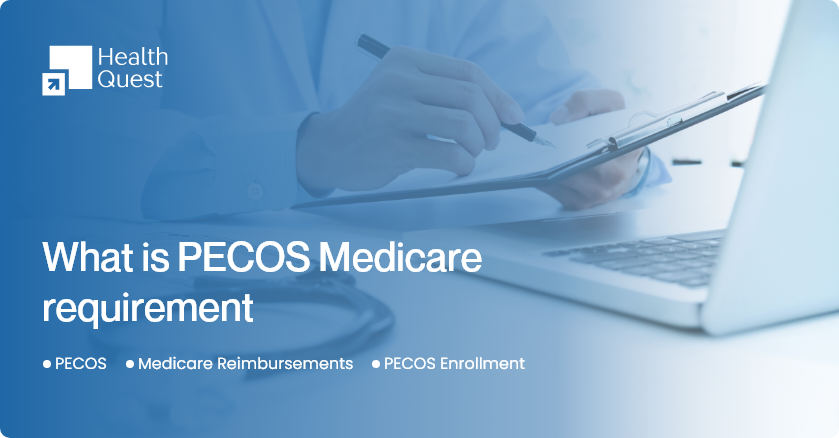If you’re a healthcare provider looking to serve Medicare patients, understanding PECOS (Provider Enrollment, Chain, and Ownership System) is crucial. PECOS is the online system from CMS that simplifies enrolling and managing your Medicare participation. With recent updates in PECOS 2.0, CMS aims to make the process faster and more user-friendly, reducing delays in Medicare reimbursements. In 2024, CMS also requires physicians certifying hospice services to be enrolled in PECOS.
In this blog, we’ll break down the essentials of PECOS and guide you through dealing with it for smooth Medicare enrollment.
What is PECOS Enrollment?
PECOS enrollment is the process healthcare providers and suppliers use to apply for participation in the Medicare program through PECOS (Provider Enrollment, Chain, and Ownership System) a secure online portal managed by the Centers for Medicare & Medicaid Services (CMS).
Why PECOS Is Essential for Medicare Providers
Enrollment in the Provider Enrollment, Chain, and Ownership System (PECOS) is essential for all healthcare providers and suppliers who wish to participate in the Medicare program. Beyond being a regulatory requirement, PECOS enrollment plays a critical role in ensuring your ability to deliver care and receive reimbursement in a timely and compliant manner.
Eligibility for Medicare Bill
Only providers and suppliers who are actively enrolled and approved in PECOS are authorized to render services to Medicare beneficiaries and submit claims for reimbursement. Without proper enrollment, Medicare will not process or pay for services rendered, regardless of medical necessity or patient eligibility.
Timely Reimbursements
Accurate and up-to-date PECOS enrollment information is directly tied to the speed and efficiency of Medicare reimbursements. Delays in enrollment, outdated data, or errors in submission can lead to claim denials, payment delays, or unnecessary administrative burdens.
Compliance with CMS Requirements
PECOS serves as a centralized system through which CMS verifies provider eligibility, ownership structure, and compliance with federal regulations. For example, as of 2024, physicians certifying hospice services must be enrolled in PECOS to fulfill Medicare requirements. Maintaining an active and accurate enrollment status helps prevent compliance risks, including audits and sanctions.
Who Must Enroll in PECOS
PECOS enrollment is required for a wide range of healthcare professionals and organizations that provide services to Medicare beneficiaries. Whether you’re billing Medicare directly or referring patients for covered services, enrollment ensures your eligibility and compliance with CMS regulations.
Provider Types Required to Enroll
The following individuals and entities must enroll in PECOS to participate in the Medicare program:
- Physicians (MDs and DOs)
- Non-Physician Practitioners, including:
- Nurse Practitioners (NPs)
- Physician Assistants (PAs)
- Certified Nurse Midwives (CNMs)
- Clinical Nurse Specialists (CNSs)
- Clinical Social Workers (CSWs)
- Clinical Psychologists
- Therapists (Physical, Occupational, Speech-Language)
- Durable Medical Equipment (DME) Suppliers
- Group Practices and Clinics
- Hospitals, Laboratories, Home Health Agencies, and other institutional providers
2024 Update: Hospice Certifying Physicians Must Enroll
As of 2024, physicians who certify or recertify hospice services for Medicare patients are required to be enrolled in PECOS, even if they do not bill Medicare directly. This CMS update aims to improve program integrity and ensure only qualified, verified physicians are authorizing hospice care.
Overview of PECOS 2.0 Updates

In response to provider feedback and the need for modernization, CMS launched PECOS 2.0 in late 2023 and into 2024. This enhanced version of the Provider Enrollment, Chain, and Ownership System is designed to simplify the enrollment process, improve transparency, and reduce administrative burden for healthcare professionals and organizations.
Below is a summary of the key enhancements introduced in PECOS 2.0:
Improved User Interface
PECOS 2.0 features a significantly upgraded interface that prioritizes ease of use and accessibility. Key improvements include:
- An Improved, modern dashboard for quick navigation
- Clear display of enrollment tasks and application status
- Enhanced functionality across desktops, tablets, and mobile devices
Simplified Revalidation Process
The revalidation process has been overhauled to eliminate redundancies and improve workflow. Enhancements include:
- Auto-populated fields from existing records
- Consolidated forms and fewer data entry steps
- Real-time data validation to minimize submission errors
Enhanced Alerts and Tracking Capabilities
To support better oversight of enrollment activity, PECOS 2.0 includes robust tracking and notification tools, such as:
- Real-time updates on application status
- Automated alerts for revalidation deadlines or required documentation
- Notifications for incomplete submissions or pending approvals
How to Enroll in PECOS?

Enrolling in PECOS can feel overwhelming at first, but breaking it down into simple steps makes the process much more manageable. Whether you’re a solo provider or part of a larger group, following the correct sequence will help you avoid delays and ensure a smooth enrollment with Medicare.
Here’s a step-by-step guide to help you get started:
Step 1: Register for an NPI
Before you can enroll in PECOS, you must have a valid National Provider Identifier (NPI). You can apply online through the National Plan and Provider Enumeration System (NPPES).
Step 2: Set Up Your Identity & Access (I&A) Account
Next, register with the CMS Identity & Access (I&A) Management System. This system is used to assign access to PECOS and other CMS platforms. You’ll need to:
- Create a username and password
- Verify your identity
- Link yourself to your organization (if applicable)
Step 3: Start Your PECOS Application
Once your I&A account is ready, log in to the PECOS portal to begin the Medicare enrollment application:
Step 4: Submit Ownership and Group Affiliation Info
You’ll be asked to provide details about:
- Practice ownership or managing control (if applicable)
- Group affiliations, including Tax Identification Numbers (TINs), reassignment of benefits, and practice locations
Step 5: Upload Required Supporting Documents
To complete your enrollment, be prepared to submit scanned copies of key documents, such as:
- State medical license(s)
- IRS letter (Form CP-575 or SS-4)
- Business or incorporation documents
- Driver’s license or state-issued ID
- EFT/ERA forms (if enrolling in electronic payments)
Common PECOS Enrollment Mistakes and How to Avoid Them
Accurate and timely PECOS enrollment is essential for maintaining your Medicare billing privileges. However, many providers encounter avoidable issues during the process. Below are some of the most common pitfalls and how to prevent them:
Submitting Incomplete Applications
Missing information or required documents is one of the most frequent causes of application delays. Carefully review all sections before submission and ensure all uploads are complete and legible.
Incorrect Business Structure Selection
Ensure that the business structure listed on your PECOS application matches your legal documents (e.g., IRS CP-575 or SS-4). Mismatches can result in rejections or delayed processing.
Missing Revalidation Deadlines
CMS requires providers to revalidate their enrollment every 3 to 5 years. Failing to respond to revalidation requests can lead to deactivation. Check your PECOS portal regularly and set calendar reminders to stay current.
Improper I&A Account Setup
The Identity & Access (I&A) system must be correctly configured to allow access to PECOS. Ensure your account is linked to the appropriate organization and roles (e.g., Authorized Official, Staff End User) are assigned accurately.
How PECOS Connects to Other Key Systems
PECOS doesn’t operate in isolation; it works in tandem with several other essential systems that support your Medicare participation. Understanding these connections ensures smoother enrollment, billing, and compliance.
CAQH (Council for Affordable Quality Healthcare)
While CAQH is a separate credentialing platform used by many commercial payers, maintaining consistency between your CAQH profile and PECOS information is vital. Many providers pull demographic and licensure data from both when applying to health plans.
NPPES (National Plan and Provider Enumeration System)
Your NPI, assigned through NPPES, is required for PECOS enrollment. Any updates to your provider or group information in PECOS should also be reflected in NPPES to avoid discrepancies that could affect claims or credentialing.
EFT/ERA Setup
PECOS is often used in conjunction with Electronic Funds Transfer (EFT) and Electronic Remittance Advice (ERA) enrollment. Ensuring that your PECOS application reflects accurate banking and billing information supports faster, secure Medicare payments.
EDI Enrollment
Electronic Data Interchange (EDI) enrollment is required to submit Medicare claims electronically. Your PECOS enrollment must be complete and active before you can be approved for EDI, making it a foundational step in your revenue cycle.
Final Thought:
Maintaining accurate PECOS enrollment is not just about paperwork; it’s a key factor in staying compliant, avoiding billing interruptions, and ensuring you get paid for services rendered.
With ongoing CMS updates, including new 2024 requirements for hospice-certifying physicians, it’s more important than ever to review and update your PECOS profile regularly.
Don’t wait for a denial or delay to address your enrollment. Take action now to protect your revenue and keep your Medicare participation in good standing.
Take Control of Your Medicare Enrollment Today
If you’re a Medicare provider or planning to become one now is the time to review your PECOS enrollment. With new 2024 requirements and a fully redesigned PECOS 2.0 system, staying compliant has never been more critical. Take a few minutes today to log in, check your status, and ensure your information is current. Don’t risk payment delays or compliance issues now and stay ahead.



